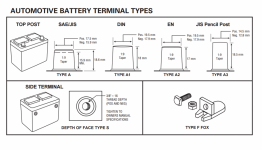- Joined
- Aug 4, 2020
- Messages
- 557
I learned a lesson the hard way this weekend. I was working on a 2013 Elantra. Very intermittent no-start condition. I noticed the positive battery terminal had a chewed up shim. I also noticed the terminal was warped, which I quickly discovered was from a previous owner's amp cable. This has been a difficult diagnosis over several weeks, so the customer agreed to a new OEM terminal (due to the strange setup of the positive connector) in order to eliminate the shim...and the variable. I had to order the part, so as a temporary measure, I used a new shim from Hyundai with the old terminal. This is what the terminal looks like (ignore the red outline):

Here is a picture of the terminal isolated from the rest of the unit:

The circumference of the inside of the terminal loop is self-tightening. When the nut pictured above is tightened, it also pulls that 'claw' piece that runs perpendicular to the terminal toward the nut, which shrinks the circumference and tightens the terminal to the post. I was hoping that the combination of a new battery and new battery terminal would fit perfectly together. Nope! The Hyundai positive battery terminal for these Elantras (Hyun/KIA part number 91980 3X010) are larger than the post by the tiniest measure, just enough to aggravate you and spin around the post. Also beware, that particular Hyun/KIA part number actually retrieves two completely different terminals. They got the correct one the second time around. No this was not counter guy malfunction, and yes I gave the VIN both times.
Long story short, I spent two hours trying to get the new terminal to work, removing, replacing, both a second time (there are about nine steps to get the terminal disconnected from the unit, then the same nine in reverse to reconnect), even installing the same terminal to another battery of the same size (different brand)...all to come to an aggravating conclusion. A shim is absolutely necessary. That also means the old terminal is perfectly capable of a secure connection with a proper shim (which I now have to get again, because after so much removing and replacing it's now sabotaged).
So 6 total hours of wasted time: four trips to the dealer (30 minutes one-way), plus two hours of frustration installing it. All to end up reverting to the imperfect parts and earning zero money. After all, why should the customer pay for what he already had?
I hate shims, but in this case they're the lesser of two evils. Hopefully this helps someone contemplating buying a new terminal or already in-progress and frustrated.
Here is a picture of the terminal isolated from the rest of the unit:
The circumference of the inside of the terminal loop is self-tightening. When the nut pictured above is tightened, it also pulls that 'claw' piece that runs perpendicular to the terminal toward the nut, which shrinks the circumference and tightens the terminal to the post. I was hoping that the combination of a new battery and new battery terminal would fit perfectly together. Nope! The Hyundai positive battery terminal for these Elantras (Hyun/KIA part number 91980 3X010) are larger than the post by the tiniest measure, just enough to aggravate you and spin around the post. Also beware, that particular Hyun/KIA part number actually retrieves two completely different terminals. They got the correct one the second time around. No this was not counter guy malfunction, and yes I gave the VIN both times.
Long story short, I spent two hours trying to get the new terminal to work, removing, replacing, both a second time (there are about nine steps to get the terminal disconnected from the unit, then the same nine in reverse to reconnect), even installing the same terminal to another battery of the same size (different brand)...all to come to an aggravating conclusion. A shim is absolutely necessary. That also means the old terminal is perfectly capable of a secure connection with a proper shim (which I now have to get again, because after so much removing and replacing it's now sabotaged).
So 6 total hours of wasted time: four trips to the dealer (30 minutes one-way), plus two hours of frustration installing it. All to end up reverting to the imperfect parts and earning zero money. After all, why should the customer pay for what he already had?
I hate shims, but in this case they're the lesser of two evils. Hopefully this helps someone contemplating buying a new terminal or already in-progress and frustrated.



